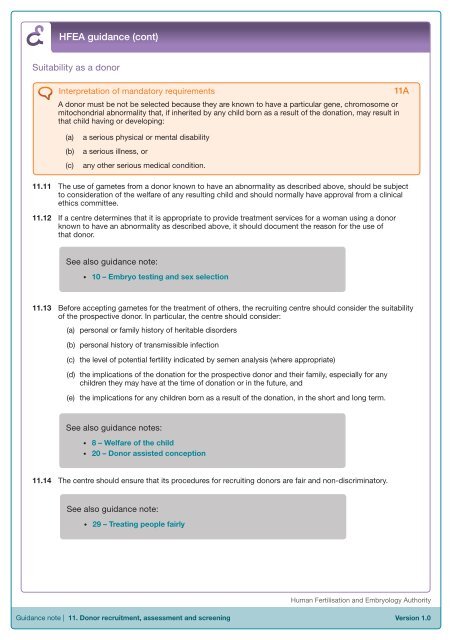Eighth Edition - R.3 - Human Fertilisation & Embryology Authority
Eighth Edition - R.3 - Human Fertilisation & Embryology Authority
Eighth Edition - R.3 - Human Fertilisation & Embryology Authority
You also want an ePaper? Increase the reach of your titles
YUMPU automatically turns print PDFs into web optimized ePapers that Google loves.
HFEA Mandatory guidance requirements (cont)<br />
Suitability as a donor<br />
Interpretation of mandatory requirements<br />
A donor must be not be selected because they are known to have a particular gene, chromosome or<br />
mitochondrial abnormality that, if inherited by any child born as a result of the donation, may result in<br />
that child having or developing:<br />
11A<br />
(a)<br />
(b)<br />
(c)<br />
a serious physical or mental disability<br />
a serious illness, or<br />
any other serious medical condition.<br />
11.11 The use of gametes from a donor known to have an abnormality as described above, should be subject<br />
to consideration of the welfare of any resulting child and should normally have approval from a clinical<br />
ethics committee.<br />
11.12 If a centre determines that it is appropriate to provide treatment services for a woman using a donor<br />
known to have an abnormality as described above, it should document the reason for the use of<br />
that donor.<br />
See also guidance note:<br />
<br />
10 – Embryo testing and sex selection<br />
11.13 Before accepting gametes for the treatment of others, the recruiting centre should consider the suitability<br />
of the prospective donor. In particular, the centre should consider:<br />
(a)<br />
personal or family history of heritable disorders<br />
(b)<br />
(c)<br />
(d)<br />
(e)<br />
personal history of transmissible infection<br />
the level of potential fertility indicated by semen analysis (where appropriate)<br />
the implications of the donation for the prospective donor and their family, especially for any<br />
children they may have at the time of donation or in the future, and<br />
the implications for any children born as a result of the donation, in the short and long term.<br />
See also guidance notes:<br />
<br />
<br />
8 – Welfare of the child<br />
20 – Donor assisted conception<br />
11.14 The centre should ensure that its procedures for recruiting donors are fair and non-discriminatory.<br />
See also guidance note:<br />
<br />
29 – Treating people fairly<br />
<strong>Human</strong> <strong>Fertilisation</strong> and <strong>Embryology</strong> <strong>Authority</strong><br />
Guidance note | 11. Donor recruitment, assessment and screening<br />
Version 1.0

















